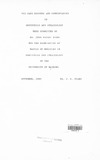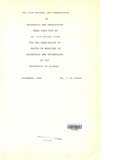| dc.contributor.author | Nyamu, J M | |
| dc.date.accessioned | 2013-05-23T06:52:59Z | |
| dc.date.available | 2013-05-23T06:52:59Z | |
| dc.date.issued | 1989-11 | |
| dc.identifier.citation | Degree of Master of Medicine in obstetrics and gynaecology of the University of Nairobi | en |
| dc.identifier.uri | http://erepository.uonbi.ac.ke:8080/xmlui/handle/11295/24603 | |
| dc.description | A Dissertation Submitted In Part Fulfillment For
the Degree of Master of Medicine (Medicine) of
the University of Nairobi | en |
| dc.description.abstract | TITLE: THE MANAGEMENT OF GRANDMULTIPAROUS PATIENTS
PREVIOUSLY DELIVERED BY CAESARIAN SECTION AT
PUMWANI MATERNITY HOSPITAL AND KENYATTA
NATIONAL HOSPITAL.
SUMMARY:
118 grandmultiparous patients with previous scar were
studied to see the outcome of labour in Pumwani Maternity
Hospital and Kenyatta National Hospital, both in Nairobi.
The study was carried out over 5 months starting from
26th November 1988 to 24th April 1989. 105 patients were
registered at Pumwani Maternity Hospital while 13 were
registered at Kenyatta National Hospital.
All the patients seen at Kenyatta National Hospital were
delivered by caesarean section while at Pumwani ~O patients
were allowed a trial of scar with 57 of these (representing:
71.2%) having a successful trial and 23 of them (representing:
28.8%) having to undergo an emergency caesarean section in the
course of labour. 25 other patients in the same study group
(Purnwani) underwent caesarean section either electively or as
a result of the clinician's decision not to try the scar when
they presented in labour.
No rupture of the uterus occurred and no rraternal death
occurred. Perinatal morbidity was low (20.9%) mainly due to
mild birth asphyxia but one baby had neonatal jaundice and
another had congenital abnormality.
188
Perinatal mortality was registered in only two babies
(1.9%) • One of the babies had decompression of the head. due to
congenital hydrocephalus. while the other had unexplained death
following failed trial of scar.
Maternal morbidity as judged by the febrile morbidity
(6/118) and septic wound (1/118) was more common in repeat
sections. Morbidity due to intrapartum haemorrhage (2/118) was
also more common in this group since 2 cases were seen after
they underwent emergency caesarean section. Postpartum
haemorrhage and retained placenta was more common in
successful trial of scar compared to repeat sections but one
patient out of 57 had retained placenta.
Trial of scar in grand multiparous patients seem to be
safe and this approach will definately reduce unnecessary
caesarean sections and also reduce the morbidity, associated hospital
stay and drugs. The deprivation of the indispensable early
maternal-infant contact after caesarean section should not
be forgot ten. | en |
| dc.language.iso | en | en |
| dc.publisher | University of Nairobi | en |
| dc.title | The Case Records and Commentaries in Obstetrics and Gynaecology | en |
| dc.type | Thesis | en |
| dc.description.department | a
Department of Psychiatry, University of Nairobi, ; bDepartment of Mental Health, School of Medicine,
Moi University, Eldoret, Kenya | |
| local.publisher | Department of Obstetrics and Gynaecology | en |


